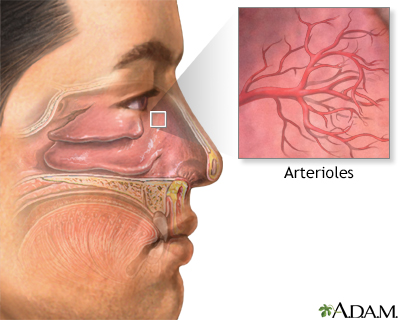Health exams for: #AGEGROUP#
The following exams, tests, and procedures are recommended for #AGEGROUPLOWER#.#FEMALETEXT#
Select a link from the list below to learn how and why each test is performed, as well how to prepare for it.

The following exams, tests, and procedures are recommended for #AGEGROUPLOWER#.#FEMALETEXT#
Select a link from the list below to learn how and why each test is performed, as well how to prepare for it.
The nose is a very vascular area of the body that contains many arterioles (tiny blood vessels) that can bleed easily. Nosebleeds occur more frequently in the winter when heated indoor air can dry the membranes of the nose. Also, air moving through the nose can also dry out the membranes and can form crusts. These crusts bleed when irritated by rubbing, picking, or blowing the nose. Occasionally, nosebleeds may indicate other disorders such as bleeding disorders, high blood pressure, or hardening of the arteries.
Review Date: 7/1/2023
Reviewed By: Jesse Borke, MD, CPE, FAAEM, FACEP, Attending Physician at Kaiser Permanente, Orange County, CA. Also reviewed by David C. Dugdale, MD, Medical Director, Brenda Conaway, Editorial Director, and the A.D.A.M. Editorial team.




